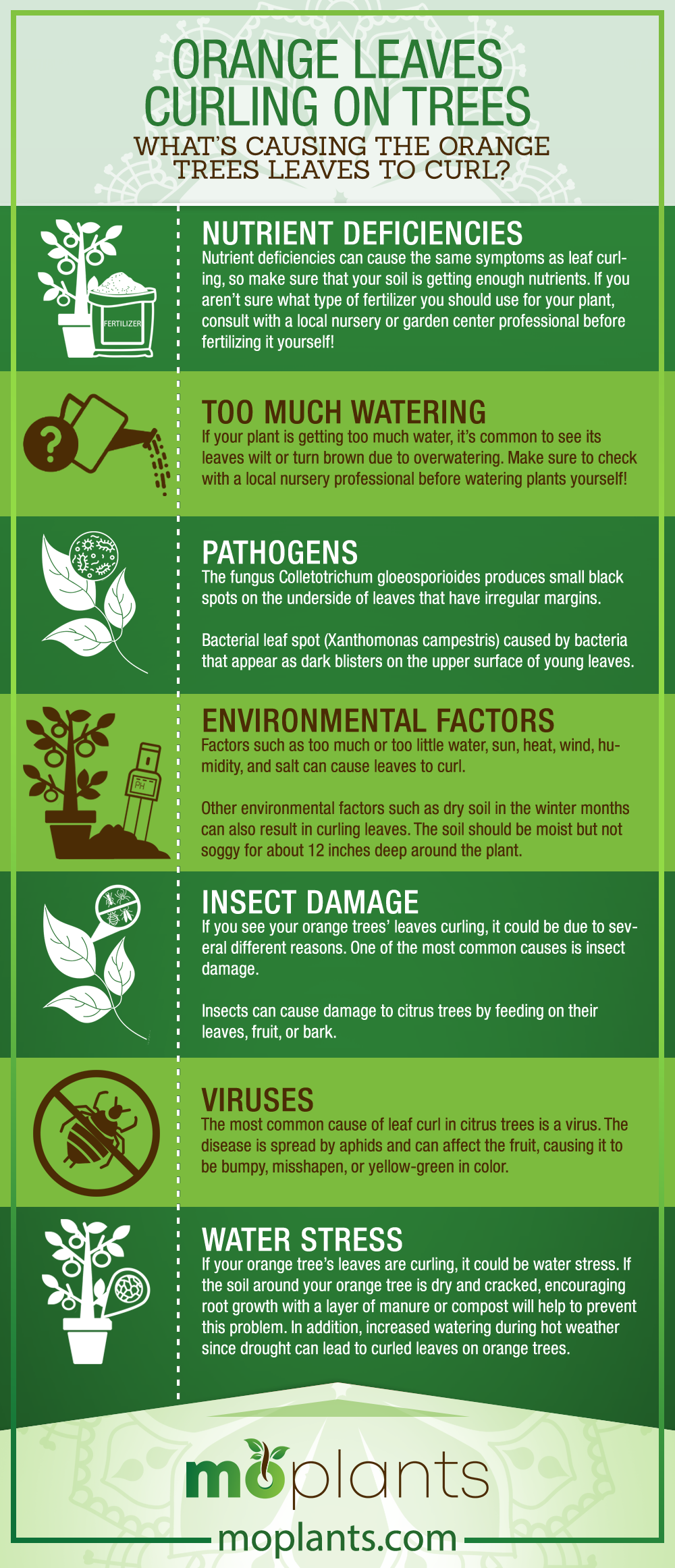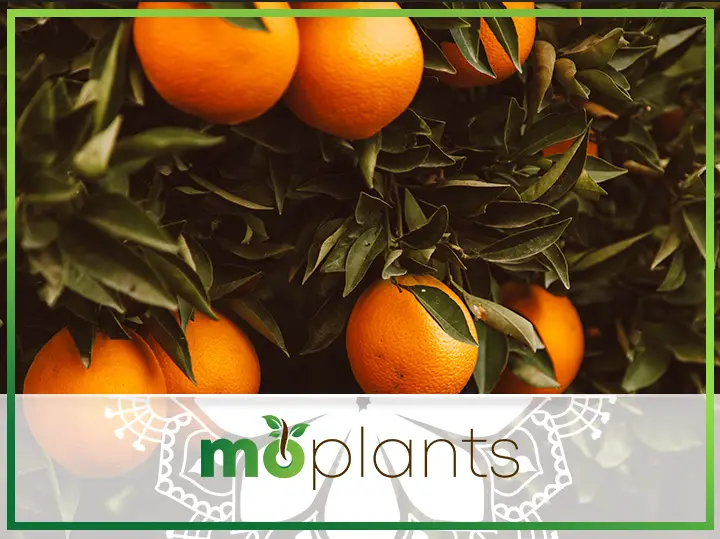Orange tree leaves that are curled or cupped are often a sign of stress. These leaves may be curling because of water stress, environmental factors such as disease or pests, or nutrient deficiencies. Let’s look at some reasons why orange tree leaves curl and how to manage them so your trees stay healthy!
Let us explain everything you need to know about curling oranges in this article.
Why Are My Orange Tree Leaves Curling?
So, why are your orange tree leaves curling and turning brown?
Orange trees are easy to grow, but that doesn’t mean they don’t have their fair share of problems. Orange trees are known to be susceptible to a number of pests and diseases, so you may notice your tree and its leaves exhibiting some unusual symptoms. One of the most common concerns for orange trees is the curling of leaves. If you see your orange tree leaves’ edges curling up, you may be wondering why this is happening and what causes it.
The reason why your orange tree leaves are curling can be multiple. First, make sure that your soil is not too acidic or alkaline, so aim for a pH of about 7. This can cause your plant’s roots to become damaged, which in turn leads to yellowing leaves and leaf curling. You will also want to check for insects or diseases that could be causing damage to your plant’s roots or leaves.
If none of these factors seem related to the problem, then you may want to try watering more frequently and extensively than usual until new growth begins again – this will help prevent further damage from occurring due to lack of water!
It’s not uncommon for citrus trees to display this condition. There are many reasons why this happens. Some of the most common include:
- Susceptibility to pests and disease (commonly known as “orange scab”)
- Extreme weather conditions
What’s Causing The Orange Trees Leaves To Curl?
There are several different reasons why your orange tree’s leaves might be turning brown or curling up, such as:
Nutrient Deficiencies
Nutrient deficiencies can cause the same symptoms as leaf curling, so make sure that your soil is getting enough nutrients. If you aren’t sure what type of fertilizer you should use for your plant, consult with a local nursery or garden center professional before fertilizing it yourself!
Too Much Watering
If your plant is getting too much water, it’s common to see its leaves wilt or turn brown due to overwatering. Make sure to check with a local nursery professional before watering plants yourself!
Pathogens
There are several pathogens that cause this problem, including fungal and bacterial diseases such as:
- Fungal leaf spot – The fungus Colletotrichum gloeosporioides produces small black spots on the underside of leaves that have irregular margins. With time, these spots turn grayish brown on the top surface of leaves, become powdery, and eventually kill the entire tree if untreated or not controlled quickly.
- Bacterial leaf spot (Xanthomonas campestris) – Caused by bacteria that appear as dark blisters on the upper surface of young leaves. It is often confused with a viral disease, but no viral particles are identified in culture samples taken from lesion sites, and it causes rapid deterioration of affected plants over several weeks.
Environmental Factors
Factors such as too much or too little water, sun, heat, wind, humidity, and salt can cause leaves to curl.
Other environmental factors such as dry soil in the winter months can also result in curling leaves. The soil should be moist but not soggy for about 12 inches deep around the plant.
Insect Damage
If you see your orange trees’ leaves curling, it could be due to several different reasons. One of the most common causes is insect damage.
Citrus trees are especially susceptible to insect damage because they live in tropical climates where insects and diseases are more prevalent. Insects can cause damage to citrus trees by feeding on their leaves, fruit, or bark. In some cases, their presence may not be apparent until you start noticing signs of leaf curl.
Viruses
The most common cause of leaf curl in citrus trees is a virus. The disease is spread by aphids and can affect the fruit, causing it to be bumpy, misshapen, or yellow-green in color.
The virus is not a problem for the tree itself but will impact its production of fruit. For example, if you have an orange tree with mild leaf curl and grow oranges on it for several years without treating the infection, you’ll notice that the fruit does not have quite as much juice as expected from healthy trees because the leaves cannot absorb nutrients from them properly due to their curled shape.
This condition can also be transferred via grafting – this means if you plant an infected rootstock next to an uninfected scion, they can exchange viruses which will then infect both parts during blooming season (flowering). A good way around this is by planting grafted plants already resistant to citrus leaf curl (CLC), such as the ‘Valencia’ hybrid orange trees, since they contain genetic resistance against CLC, allowing them to produce tasty fruit year after year without any problems.
Water Stress
If your orange tree’s leaves are curling, it could be water stress. If the soil around your orange tree is dry and cracked, encouraging root growth with a layer of manure or compost will help to prevent this problem. In addition, increased watering during hot weather since drought can lead to curled leaves on orange trees.
To avoid over-watering, do not water in the evening as this will encourage fungus growth and root rot on your orange tree.
Infographic

How Can You Fix Curled Orange Tree Leaves?
To fix a curled orange tree leaf, you’ll need to take care of two things. First, prune the tree by cutting off any dead or brown leaves. Then, water it and remove any dead branches that may be preventing the roots from getting enough water. After this, fertilize your tree with a citrus fertilizer at least once per year during its dormant period (when there are no blooms).
How Many Years Does It Take For An Orange Tree To Produce Fruit?
You should be able to harvest your first orange in two to three years. However, it’s important that you maintain your tree properly during this time. You should fertilize and prune it every year to keep its health at its peak. Additionally, you need to water the tree regularly. If you do all these things right, your orange tree will produce fruit much sooner!
Although it can take a few years for an orange tree to start producing fruit, once it does start bearing fruit—as long as you take care of the plant—you’ll be overwhelmed with oranges almost immediately!
Can You Plant An Orange Seed And Get An Orange Tree?
Yes, you can grow an orange tree from a seed. You must plant the seed in a pot and keep it watered and fertilized. The tree will need about four years to reach full maturity, but you can expect to harvest fruit from your tree within two years of planting it.
To grow an orange tree from seed:
- Soak your seeds for 24 hours in warm water to soften them
- Fill each pot with soil until the top is level with its rim
- Plant one seed per pot at least 2 inches deep (or 3-4 inches deep for larger trees)
- Water your pots until the soil is damp but not soggy (about once per week)
There are many reasons that your orange tree leaves may be curling, but there is always a fix.
There are several causes for leaf curling on orange trees. The most common reasons for orange tree leaves curling include:
- Overwatering (mudballs)
- Underwatering (yellowing of leaf tips)
- Too much fertilizer (burning of leaf tips)
- Poor drainage of soil/soggy roots from too much water/frost damage to the root system
Our Final Thoughts
To determine what is causing the problem, look at your tree and see if there are any signs of insects, fungi, or other pests that may be causing damage to the leaves. If so, you will have to treat them before they spread and make your orange trees curl. The good news is that once treated, they should recover quickly and resume growing normally.

